This post contains affiliate links.
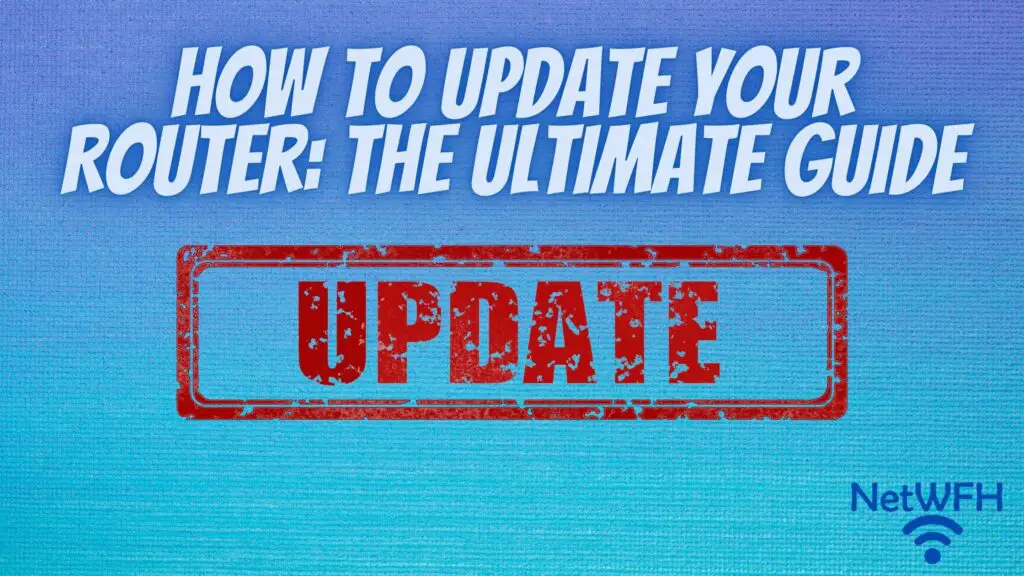
Everyone should update their router.
The problem is, it’s not always clear how to update your router. On top of that, you may not be sure why you even should be updating it in the first place.
The good news is that the process itself isn’t very complicated.
You essentially have to log in to your router’s settings to see if there are updates available for your router. If there are, it only takes a few clicks and your router will have the latest and greatest software version.
The hardest part about it is making sure you don’t update your router over a WiFi connection. Your computer should be plugged directly into your router to make sure the updates install smoothly.
Updating your router only takes a few minutes of your time and it’s well worth it.
In this post I’ll break down all you need to know about updating your router. Everything from what your router firmware is, the benefits of keeping it updated, and how often you should be checking for updates.
Let’s take it from the top.
What is router firmware?
When you update your router, you’re actually updating the firmware on the device.
So what is firmware?
Firmware is just a fancy term for the software that comes with the router when you buy it. It’s installed on the router hardware itself, and you’re not allowed to change any of its settings.
In other words it’s considered read-only memory, or ROM.
The only way you can change your router’s firmware is by installing an update for it, or by installing new firmware on the device entirely.
So what does it do?
Your router’s firmware is responsible for making sure the device runs properly.
In fact, a lot of the firmware works behind the scenes and you hardly even notice it.
For example, it allows your router to communicate with your devices so they can talk to each other and access the internet. This includes assigning IP addresses to your devices when they’re connected to your router.
On top of that, it makes sure your router starts properly when you turn it on and reboot it.
Your router’s firmware also includes the interface that allows you to log in to your router and change its configuration settings.
To put it simply, without firmware your router would just be a paperweight.
Why should you update your router’s firmware?
There are two main reasons why your router’s firmware needs to be updated.
A good analogy here is if you think about an application on your smart phone.
Why do your smart phone apps need to be updated?
Better performance
For one, the creators of your smartphone applications are constantly making improvements to make it run faster and more efficiently.
This goes hand in hand with advancements in technology. As new technologies are developed, the code of these applications can be written to utilize these new technologies. As technology improves, so too can applications that have already been created.
In addition to new ways of developing apps, there are always bugs that are found after software is released. The only way for application developers to fix these bugs is to issue new versions of their software.
This is why you get application updates so frequently for your phone. There are always changes that can be made to write better applications.
The same principle applies if an application has a new capability or feature the developers want to add. In order to roll out the new feature or capability, an update needs to be issued.
The examples above for applications are all applicable to your router firmware as well.
There’s always room for improvement of your router’s firmware. If you look at the notes for a router firmware update you’ll usually see that bug fixes are addressed in the update:
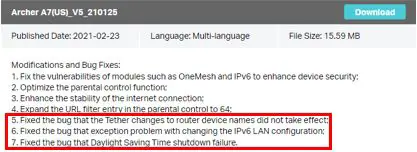
There’s a lot at stake here, because improving your router’s firmware can cause all of your devices to communicate better and have faster internet speeds.
I don’t think anyone would complain about better performance from their router.
More secure
Updating your phone’s applications also makes them more secure from hackers.
Just like fixing bugs in an application, it’s completely normal for developers to notice security flaws in their software code.
In order to fix these flaws and close the security holes, updates are issued for the application.
Unfortunately, there’s another factor at play here as well. Hackers are finding new ways to hack applications just as quickly as old security issues are being fixed.
This results in an arms race where hackers find a new way to hack into software, then the application developers write code to fix the security issue.
Then hackers find another way in.
Then developers fix the code of their application to close that door.
I’m sure you can see where this is going.
It’s a never-ending battle between developers and hackers. This is another reason why your applications are getting updated so frequently.
Your router is no different. As security vulnerabilities are discovered, your router manufacturer issues fixes to secure the router firmware.
This is why you’ll usually see “Enhance Device Security” in the notes when you update your router.
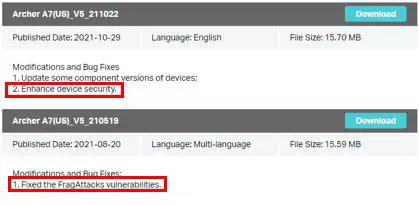
Your router’s manufacturer is constantly improving the firmware of its devices to keep you safe from hackers.
The only way you get these benefits is if you’re updating your router.
Is that convincing enough?
How do you update your router’s firmware?
Now that you know how important updating your router is, let’s discuss how you actually go about updating it.
There are two ways to update your router. You can either update your router by having it automatically install the latest firmware version, or you can manually download the firmware update yourself and install it on your router.
Let’s walk through both methods so you have your bases covered.
I will be describing the steps for updating my TP-Link Archer A7 router. Don’t worry if you have a different router because the steps for your router will most likely be similar.
How to automatically install router updates through the router’s settings
The first method for updating your router is the easiest. It’s also the method you’ll need to use the vast majority of the time.
When you log in to your router’s settings, you’ll be able to automatically check if a new version of firmware is available.
To do this, you first need to log in to your router’s settings.
Access your router’s login page
To log in to your router’s settings, you’ll need to know the IP address or default location for your router.
The easiest way to determine this will be to look at the sticker on your router. The sticker will usually provide the default location for your router’s settings.
Let’s take a look at the sticker on my router as an example:

The default access location for my router’s settings is http://tplinkwifi.net. If I type this location into my internet browser, it’ll take me to my router’s login page.
The other option here is to use your router’s IP address.
If you don’t know your router’s IP address, you can find it through the command line of your computer.
If you have a Windows computer, type “cmd” in the Windows search bar and press enter.
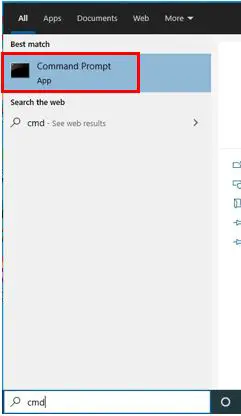
This will open a command prompt window.
In the command prompt window, type “ipconfig” to bring up the IP address information for your computer. If you have a Mac or Linux operating system, use the “ifconfig” command.
If you look at the IP address next to “Default Gateway”, that’ll be your router’s IP address.
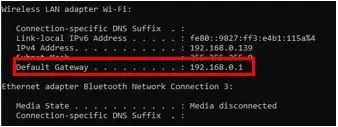
From this information I can tell my router’s IP address is 192.168.0.1. If I type my router’s IP address into my browser it will bring up my router’s login page as well.

Log in to your router
At your router’s login page, you’ll need to enter the username and password for your router.
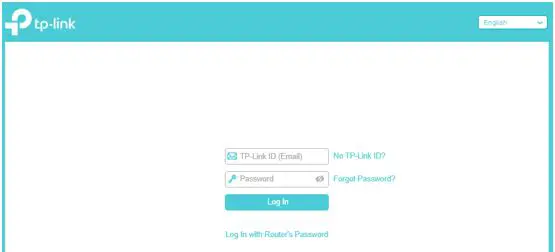
Your password will be whatever you previously chose for your router login.
Note, this password is not the same as your WiFi network password.
If you haven’t set up a unique password for your router yet, you can log in to your router with the default credentials that came with it. These can be found in your router’s user manual, or you can look them up online.
If you haven’t set your password to something other than the default password, you need to.
It’s a huge security risk for your router to have the default password set. Anyone can look up the default username and password for your router online. You don’t want anyone to have access to your router’s settings other than you.
If you’ve changed your router’s password away from the default value but you don’t remember it or you’re unable to log in, you might want to thinking about performing a factory reset of your router.
Access your router’s firmware upgrade page
Now that you’ve logged in to your routers settings, you’ll be brought to the main settings page.
In order to get to the firmware upgrade page, you need to find the advanced settings. For my router, I need to click the Advanced tab at the top of the page.
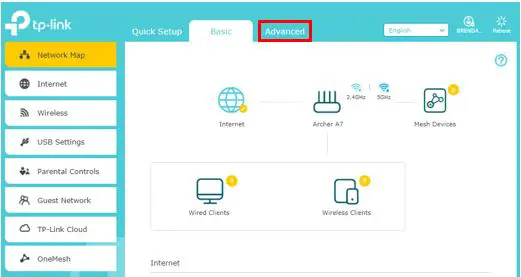
This’ll bring you to a new page with advanced settings options for your router.
To get to the firmware upgrade option, I need to click the System Tools tab.
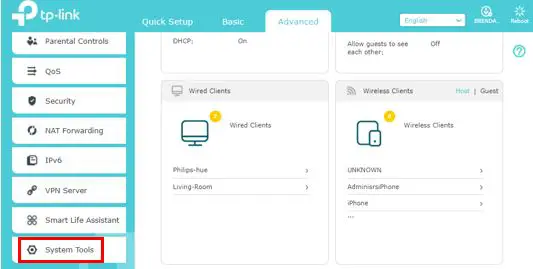
Upon clicking the System Tools header, a list of further options is provided.
It’s pretty easy from here, as I just need to select the Firmware Upgrade option.
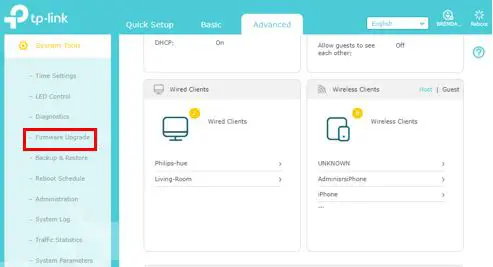
The resulting page will show everything you need to know about your router’s firmware.
You’ll see details about the current version of firmware installed, as well as the hardware version of the router.

Check for a router firmware update
The router Firmware Upgrade page also provides the option of checking to see if there’s a newer firmware version available for your router.
Here’s what it looks like for my router:
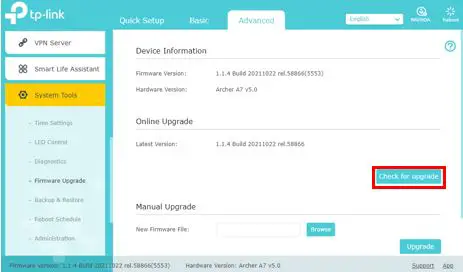
Upon clicking the “Check for Upgrade” option, your router will automatically check to see if a newer version of firmware is available.
If no firmware update is available, you’ll be notified that your firmware is up to date.
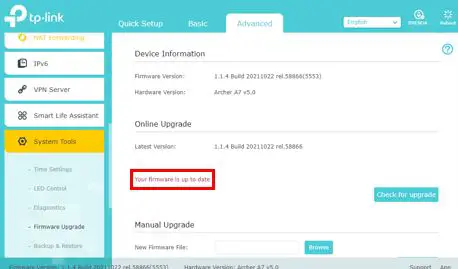
If a firmware update is available for your router, details about the firmware update will be provided. You’ll also be given the option to upgrade your router’s firmware.
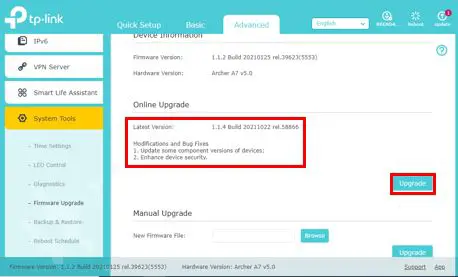
Important notes before upgrading your router
Before you upgrade your router’s firmware, you need to connect your computer to your router with an ethernet cable. This is very important.
Connecting your computer to your router will ensure the firmware upgrade completes. If you try to upgrade your firmware over a wireless connection you could lose your internet connection. If this happens during the upgrade it may not complete, and it can break your router.
This has happened to me before and I had to get a replacement router. I can’t stress this enough. Connect your computer to your router with an ethernet cable when you upgrade its firmware.
If you don’t have an ethernet cable to connect your computer and router, grab a 7 foot Cat5e ethernet cable here.
It’s also recommended that you unplug any USB devices from your router while you update its firmware. USB devices can sometimes get wiped of all their data during a firmware upgrade.
Upgrade your router
Once your computer is connected to your router and any USB devices have been removed from your router, select “Upgrade”. This will start the firmware update process.
Another important note is to make sure you aren’t using your internet connection while your router is updating. This can also break your router update while it’s in progress.
You just need to be patient here because the upgrade can take a few minutes. Your router will need to install the firmware update and restart before it’s up and running again.
During the update you may see a status bar to show the progress of the update. This will make it easy to determine where your router is in the update process.
Once the update is complete your internet connection will be stored and you’ll be able to use the internet again as usual.
The only difference is you’ll have better firmware working behind the scenes to give you a better experience.
Now let’s look at the process for manually updating your router.
How to manually install a router’s firmware update
In most cases, automatically updating your firmware through your router’s settings will be your best bet. However, sometimes you may want to perform a manually update.
For example, this is the best method if you want to download a specific version of firmware.
By downloading your router’s firmware update manually, you can select the version you want. When you automatically update your firmware, it’ll just update to the most recent version.
So how do you manually update your router’s firmware? The process is a little different from the automatic update.
Go to the manufacturer’s support page
In order to manually update your router’s firmware, you’ll first need to download the firmware that you want to upload to your router?
Where do you find your router’s firmware?
As an example, I’ll walk you through the process I followed for manually updating my router. If you have a different router manufacturer your process will probably be a little bit different, but the main steps will be the same.
You’ll need to navigate to the downloads section of the support page for your router. This can be found somewhere on the manufacturer’s website.
In my case, the manufacturer of my router is TP-Link. To get to the downloads page, I first need to navigate to TP-Link’s website.
On TP-Link’s website, I was able to find the download center from a dropdown on the main page. From there, all I had to do was select the model of my router (TP-Link Archer A7).
The resulting page provided me with everything I’d ever need for my router.
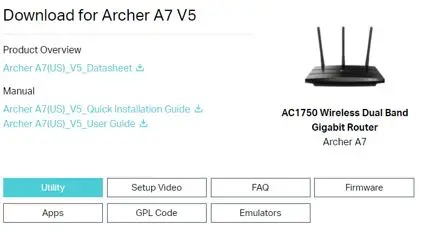
I can download my router’s user manual, view the router overview, and access frequently asked questions all from this page. In addition, users are able to download different versions of firmware for their router.
I selected the firmware header to get to the firmware downloads page.
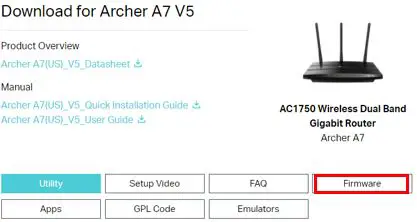
Download the firmware version you want
On the resulting page, important steps to take when manually updating your firmware were provided. There were also multiple versions of firmware that were available for download.
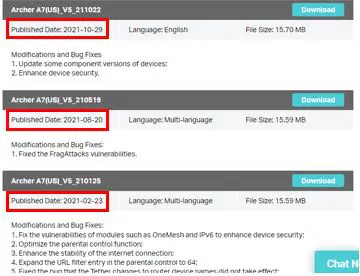
As you can see, the published date identifies when the firmware update was first released.
In my case, I wanted to download the most recent version of firmware.
I downloaded the firmware version with the most recent published date.
This downloaded a zip file that I saved in my documents. A zip file is just a group of multiple files that are compressed to take up less space on your computer when you download them.

The instructions on the firmware download page said I had to unzip the file before I uploaded it to my router. This is an easy process, but if you’re unfamiliar with unzipping a file you can follow these steps. Once unzipped, the folder looked like this:
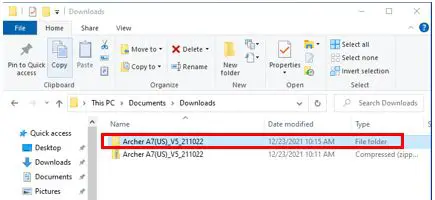
Once I unzipped the folder, I was able to see the files inside it.
I noticed there was a binary file in the folder (ending in .bin). The other files were PDF documents so I knew this was the file I needed to use to update my router’s firmware.
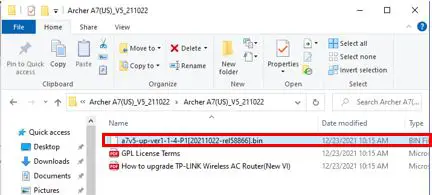
At this point I had all I needed to update my router.
Update your router’s firmware
As noted previously, before I began the firmware upgrade process, I plugged my computer into my router with an ethernet cable. Again, this is very important.
To upload this binary file to my router, I had to log in to my router as detailed in the steps to automatically update my router.
On the Firmware Upgrade page, there’s a section for manually upgrading your router.
I clicked the “Browse” button and navigated to the location of the binary file I recently downloaded. After highlighting the binary file I clicked “Open”.
I could tell the binary file was properly selected because the name of the firmware file was listed next to the “Browse” button.
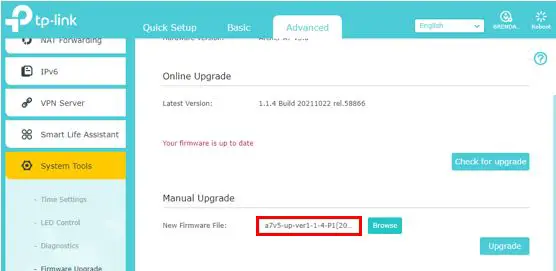
From there, all I had to do was select “Upgrade” on the Firmware Upgrade screen.
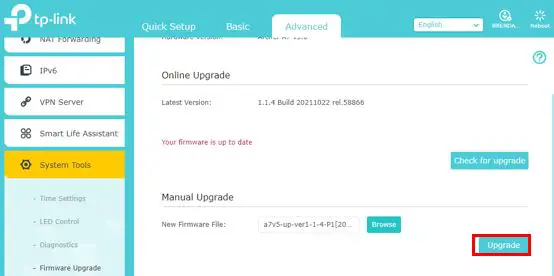
A window popped up confirming that I wanted to upgrade my router’s firmware.
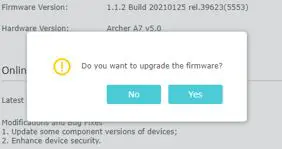
I selected yes and the firmware update process began.
Once the firmware was uploaded to my router and it reset, the update process was complete.
How do I update my router if I have a modem router combination device?
If your modem and router are combined into one device, the process for updating your router is different.
With a modem router combination device, no action is needed on your part to install updates.
Why’s that?
When your modem and router are combined, your internet service provider (ISP) is responsible for updating your device. Your ISP is responsible for pushing updates to your modem if your modem and router are separate devices, so when your modem and router are combined they’re responsible for your router’s updates as well.
As a result, your ISP will push updates to your modem and router device when they become available. In fact, you probably won’t even notice when your router gets updated.
Although this may sound great, it’s still important for you to make sure your modem router combo is being updated. I’ve seen many cases of ISPs not updating their users equipment as often as they should (if at all).
If your ISP isn’t updating your modem and router device, you’ll need to contact them to make sure they’re aware of this issue.
How do I know if my router’s firmware is up to date?
When it comes to checking for newer versions of router firmware, there’s no easy way out.
The best way to check for router updates is to log in to your router and select the “Check for Upgrade” button.
I know what you’re thinking.
It’s a pain to log in to your router and manually check for updates. There must be an easier way.
Some manufacturers offer e-mail lists that’ll send you notifications when updates are available, but from what I’ve read these notifications are unreliable. In some cases it took months for users to get notified that a new firmware update was available.
When it comes to firmware updates that could impact your router’s security, you want to make sure you install them soon after they’ve been released. You don’t want your router to spend months without an important security update.
So my advice is as follows: every month or two, log in to your router and check for firmware updates.
It takes less than a minute to log in to your router. It’s well worth your time to make sure your router is upgraded.
After all, the firmware updates can only help you. Not only from a security perspective, but from a performance perspective as well. If you’re going to pay good money for a router, you might as well get the best performance out of it.
Updating your router will ensure it’s both safe and fast.
How often should you update your router’s firmware?
The simple answer here is: as often as you can.
Unfortunately you can’t update your router on a set schedule. Manufacturer’s don’t put out router updates on a consistent basis.
That’s because they issue updates whenever they discover bugs or security issues that need fixing.
This adds a layer of complexity to updating your router. It makes it much harder to update your router when you don’t know when updates will be published.
Take my TP-Link router for example. Let’s go back to the latest three firmware updates for my router:
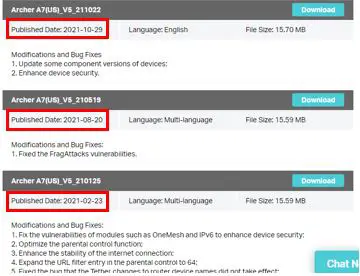
In 2021, TP-Link issued updates for my router in February, August, and October.
See? That doesn’t exactly follow a consistent schedule.
Your best bet is to just make it a habit to check for router updates. Whenever an update is available, update your firmware by following the processes I detailed above.
Wrap up
In conclusion, you need to make installing router updates a habit. Updating to the latest firmware for your router will guarantee that your router is running smoothly and in a secure manner.
If you have any questions about the information I provided, or if you’d like to share your router update experiences, please drop a comment below.
If you found this information useful, check out similar topics that I’ve previously written about:
Can I Use a Router Without a Modem?
How to Save and Restore Your Router Configuration
Can I Move My WiFi Router to Another House?
